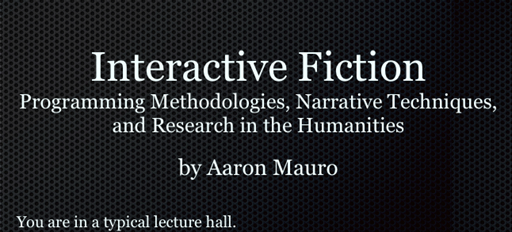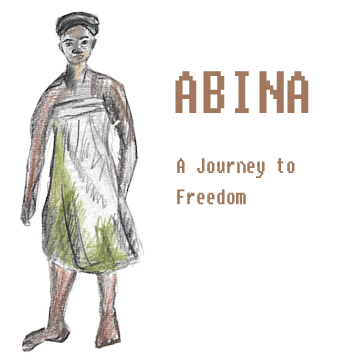Interactive Fiction by aaronmauro

This is a text adventure version of a conference paper delivered at the meeting of the Canadian Society for Digital Humanities at the Congress of the Humanities in 2014 (http://csdh-schn.org). Come in and have a seat. Listen to the presentation and have a conversation about the possibilities of game development in university education.
Here is the original abstract for the paper:
On October 17th, 2013, iOS app developer Simogo released an experimental visual novel entitled Device 6. Despite how the app breaks from the generic categories of Apple’s AppStore, this puzzle book, which incorporates game elements within the narrative, promptly sold over 100,000 copies and redefined the story telling capabilities of smart phones and tablets. Not since the heyday of Infocom in the 80s has interactive fiction been so popular. The Cambridge, Massachusetts based Infocom came to fame in 1980 with the release of Zork I, which was able to run on many of the most popular personal computers like the Apple II and the Commodore 64. After the successful release of many more games and the release of the failed database software Cornerstone in 1985, Infocom’s fortunes dwindled and all their assets were purchased by Activision in 1986. Infocom was famous for including elaborate paper maps and guides for their text adventure games, and these “feelies” served as an early analogue form of DRM because the games are nearly unplayable without them. The release of Device 6 has seen a similar commingling of interactive storytelling and the need for paper supports, since the game is nearly impossible to finish without writing down the clues to the puzzle. With the recent rerelease of the Infocom library by Activision on the AppStore in January 2013, there appears to be a surge of interest in text adventure with the spread of smart phones and tablets. In fact, there is even a burgeoning community of authors and developers producing new text adventure games on the Quest platform published by Alex Warren and Rachel Kelly (http://textadventures.co.uk), Renpy (http://www.renpy.org), or Twine (http://twinery.org). This paper will describe how the gameplay mechanics behind these systems represents a long and evolving tradition of interactive fiction and how the Quest platform might be used to teach good programming methodology and narrative technique. The platform holds the capacity for a uniquely interactive form of scholarship and an opportunity to break from the doldrums of academic publishing and distribute research through interactive mobile apps. I will finally offer a glimpse of how the Quest platform can be used to write and share a playable version of this very presentation.
Here is the original abstract for the paper:
On October 17th, 2013, iOS app developer Simogo released an experimental visual novel entitled Device 6. Despite how the app breaks from the generic categories of Apple’s AppStore, this puzzle book, which incorporates game elements within the narrative, promptly sold over 100,000 copies and redefined the story telling capabilities of smart phones and tablets. Not since the heyday of Infocom in the 80s has interactive fiction been so popular. The Cambridge, Massachusetts based Infocom came to fame in 1980 with the release of Zork I, which was able to run on many of the most popular personal computers like the Apple II and the Commodore 64. After the successful release of many more games and the release of the failed database software Cornerstone in 1985, Infocom’s fortunes dwindled and all their assets were purchased by Activision in 1986. Infocom was famous for including elaborate paper maps and guides for their text adventure games, and these “feelies” served as an early analogue form of DRM because the games are nearly unplayable without them. The release of Device 6 has seen a similar commingling of interactive storytelling and the need for paper supports, since the game is nearly impossible to finish without writing down the clues to the puzzle. With the recent rerelease of the Infocom library by Activision on the AppStore in January 2013, there appears to be a surge of interest in text adventure with the spread of smart phones and tablets. In fact, there is even a burgeoning community of authors and developers producing new text adventure games on the Quest platform published by Alex Warren and Rachel Kelly (http://textadventures.co.uk), Renpy (http://www.renpy.org), or Twine (http://twinery.org). This paper will describe how the gameplay mechanics behind these systems represents a long and evolving tradition of interactive fiction and how the Quest platform might be used to teach good programming methodology and narrative technique. The platform holds the capacity for a uniquely interactive form of scholarship and an opportunity to break from the doldrums of academic publishing and distribute research through interactive mobile apps. I will finally offer a glimpse of how the Quest platform can be used to write and share a playable version of this very presentation.
Review
by inktail
08 Dec 2017
Interesting! I like the idea of presenting definitions as part of a text adventure. Most text blocks overflowed the readable area, though, so a wait {} or two could have gone a long way in those blocks. I was hoping that the people in the first room would have interesting things to say about the topic, and that you could use the different rooms to represent different ideas, like a mind map, maybe with characters to talk about the ideas.
Review
by LewisMC
28 Mar 2015
Review
by Cepheid
20 May 2014
I'm interested in digital humanities so when I saw the premise I of course wanted to give it a try. It's obviously meant for people who have actually heard or read the paper rather then just random people who stumble across it on the internet but I still think it was a lot of fun. Short and funny and interesting--I especially enjoyed picking up the rug, ha ha.
Log in to post a review or comment.
Average rating
Written by
aaronmauro
Plays
3618
Downloads
1994
Download file
Written for Quest 5.5
Published 15 May 2014
Updated 23 Oct 2014
More Educational Games

Educating Youth about Relationships through Videogames

Abina's Journey to Personal Freedom

How to find a place to stay

Would you have survived the Salem witch trials?

Quattro personaggi in cerca di cittadinanza
 Fantasy
Fantasy
 Comedy
Comedy
 Horror
Horror
 Educational
Educational
 Sci-Fi
Sci-Fi
 Mystery
Mystery
 Puzzle
Puzzle
 Simulation
Simulation
 Surreal
Surreal
 RPG
RPG
 Slice of Life
Slice of Life
 Historical
Historical
 Literature
Literature
 Romance
Romance
 Seasonal
Seasonal